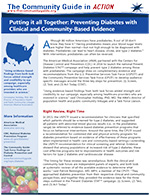Putting it all Together: Preventing Diabetes with Clinical and Community-Based Evidence
Summary
 Of the eighty-six million Americans with prediabetes, nine out of 10 don’t know they have it. Prediabetes can lead to heart disease, stroke, and type 2 diabetes. The American Medical Association partnered with the Centers for Disease Control and Prevention in 2016 to launch the national Prevent Diabetes STAT campaign to help manage prediabetes and its associated health risks. Using Task Force recommendations on evidence-based diabetes programs, Prevent Diabetes STAT aims to reduce the number of individuals with prediabetes who develop type 2 diabetes. (Released 2017)
Of the eighty-six million Americans with prediabetes, nine out of 10 don’t know they have it. Prediabetes can lead to heart disease, stroke, and type 2 diabetes. The American Medical Association partnered with the Centers for Disease Control and Prevention in 2016 to launch the national Prevent Diabetes STAT campaign to help manage prediabetes and its associated health risks. Using Task Force recommendations on evidence-based diabetes programs, Prevent Diabetes STAT aims to reduce the number of individuals with prediabetes who develop type 2 diabetes. (Released 2017)
Listen to an audio clip (7:21) of Drs. Christopher Holliday and Patrick Remington as they talk with CDC’s Dr. John Anderton about the development of the Prevent Diabetes STAT campaign and the benefits of drawing from evidence-based recommendations.
Download transcript [PDF – 170 kB]
Lessons Learned
- Better together. Combining evidence from the U.S. Preventive Services Task Force and the Community Preventive Services Task Force strengthened the overall approach for the Prevent Diabetes STAT campaign.
- Prevention from A Z. Recognizing the value of healtcare providers’ time, Prevent Diabetes STAT included print-ready materials and a link to an online registry of evidence-based prevention programs.
Story
The American Medical Association (AMA) partnered with the Centers for Disease Control and Prevention (CDC) in 2016 to launch the national Prevent Diabetes STAT campaign and help prevent type 2 diabetes among those with prediabetes. The campaign drew on complementary evidence and recommendations from the U.S. Preventive Services Task Force (USPSTF) and the Community Preventive Services Task Force (CPSTF) to develop audience-specific messages around the three key steps for prevention: (1) Screen, (2) Test, and (3) Act Today (STAT).
“Using evidence-based findings from both task forces added strength and credibility to our campaign, especially among healthcare providers who are invested in science,” said Christopher Holliday, PhD, MD, the AMA’s director of population health and public community linkages and a Task Force Liaison.
Right Review, Right Time
In 2015, the USPSTF issued a recommendation for clinicians that specified which patients should be screened for type 2 diabetes, and suggested all patients with abnormal blood glucose results (i.e., in the prediabetes range) be referred to evidence-based diabetes prevention programs that focus on behavioral interventions. Around the same time, the CPSTF issued a recommendation for combined diet and physical activity programs for diabetes prevention based on evidence of effectiveness of these programs when implemented in health care and community-based-settings extending the USPSTF recommendation for clinical screening and referral. Evidence showed that among populations at increased risk of type 2 diabetes, these cost-effective programs led to improvements in health outcomes and risk factors for type 2 diabetes and cardiovascular disease.
“The timing for these reviews was serendipitous. Both the clinical and community task forces are independent panels of experts, and both look at systematic reviews of all the available evidence to determine what works,” said Patrick Remington, MD, MPH, a member of the CPSTF. “They approached diabetes prevention from their respective clinical and community perspectives, and together they provided the evidence base for the three steps outlined in the Prevent Diabetes STAT campaign: (1) Screen, (2) Test, and (3) Act Today.”
Pulling the Pieces Together
Prevent Diabetes STAT used the evidence base to develop audience-specific messaging and connect the dots. The website, preventdiabetesstat.org provides a free toolkit with print-ready materials to help providers engage health care teams and incorporate screening, testing, and referral into their practice.
The site also connects with the National Diabetes Prevention Program, which provides resources for healthcare providers and public health practitioners, and hosts an online registry of evidence-based behavioral interventions across the country.
Reaching Out, Reaching In
Healthcare providers, practices, and public health departments provided input during development of the toolkit, and continue to offer suggestions and share how they use the different pieces. Preliminary data showed that within the first year of the campaign, roughly 10,000 individuals accessed the website which provides portals for patients and partners, healthcare professionals, and employers and insurers. The American Medical Association plans to evaluate the campaign as it progresses.
1Centers for Disease Control and Prevention, National Diabetes Prevention Program: About Prediabetes & Type 2 Diabetes. Accessed on 12/2/2016. Available at URL: https://www.cdc.gov/diabetes/prevention/prediabetes-type2/index.html
More Information
CDC, National Diabetes Prevention Program
U.S. Preventive Services Task Force
Community Preventive Services Task Force findings referred to in this story:
The Community Guide: Task Force Findings on Diabetes Prevention and Control